Review of Cross-Cultural Management & Global Leadership Evolution
VerifiedAdded on 2023/06/13
|9
|2538
|492
Report
AI Summary
This report provides a comprehensive review of an article focusing on the evolution of global leadership through the lens of cross-cultural management. It highlights the article's thesis on the transformation of management practices due to globalization and diverse socio-cultural backgrounds of employees. The review emphasizes the importance of international management in equipping managers with skills to navigate external market forces and effectively utilize organizational resources. It traces the historical development of cross-cultural management, from its emergence after World War II to the rise of globalization and multiculturalism in the workplace. The review also discusses key concepts such as unicultural, comparative, and intercultural perspectives, and underscores the significance of cultural preservation, training, and reasoned behavior in achieving organizational goals and maintaining a competitive edge in the global market. The document is available on Desklib, a platform offering a wide range of study resources for students.

Running head: CROSS CULTURAL MANAGEMENT
Article review on cross-cultural management
Name of the student:
Name of the university:
Author note:
Article review on cross-cultural management
Name of the student:
Name of the university:
Author note:
Paraphrase This Document
Need a fresh take? Get an instant paraphrase of this document with our AI Paraphraser
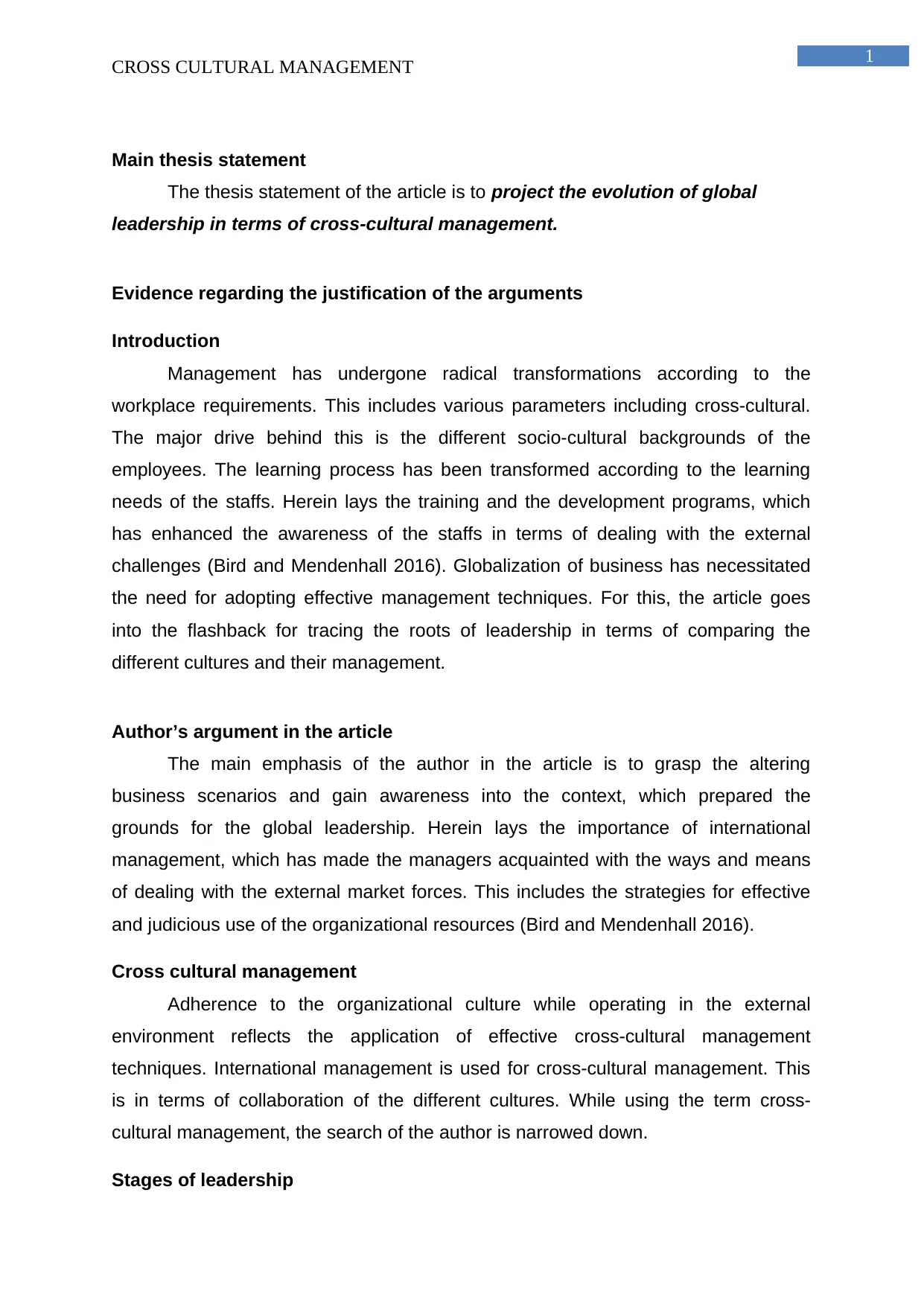
1
CROSS CULTURAL MANAGEMENT
Main thesis statement
The thesis statement of the article is to project the evolution of global
leadership in terms of cross-cultural management.
Evidence regarding the justification of the arguments
Introduction
Management has undergone radical transformations according to the
workplace requirements. This includes various parameters including cross-cultural.
The major drive behind this is the different socio-cultural backgrounds of the
employees. The learning process has been transformed according to the learning
needs of the staffs. Herein lays the training and the development programs, which
has enhanced the awareness of the staffs in terms of dealing with the external
challenges (Bird and Mendenhall 2016). Globalization of business has necessitated
the need for adopting effective management techniques. For this, the article goes
into the flashback for tracing the roots of leadership in terms of comparing the
different cultures and their management.
Author’s argument in the article
The main emphasis of the author in the article is to grasp the altering
business scenarios and gain awareness into the context, which prepared the
grounds for the global leadership. Herein lays the importance of international
management, which has made the managers acquainted with the ways and means
of dealing with the external market forces. This includes the strategies for effective
and judicious use of the organizational resources (Bird and Mendenhall 2016).
Cross cultural management
Adherence to the organizational culture while operating in the external
environment reflects the application of effective cross-cultural management
techniques. International management is used for cross-cultural management. This
is in terms of collaboration of the different cultures. While using the term cross-
cultural management, the search of the author is narrowed down.
Stages of leadership
CROSS CULTURAL MANAGEMENT
Main thesis statement
The thesis statement of the article is to project the evolution of global
leadership in terms of cross-cultural management.
Evidence regarding the justification of the arguments
Introduction
Management has undergone radical transformations according to the
workplace requirements. This includes various parameters including cross-cultural.
The major drive behind this is the different socio-cultural backgrounds of the
employees. The learning process has been transformed according to the learning
needs of the staffs. Herein lays the training and the development programs, which
has enhanced the awareness of the staffs in terms of dealing with the external
challenges (Bird and Mendenhall 2016). Globalization of business has necessitated
the need for adopting effective management techniques. For this, the article goes
into the flashback for tracing the roots of leadership in terms of comparing the
different cultures and their management.
Author’s argument in the article
The main emphasis of the author in the article is to grasp the altering
business scenarios and gain awareness into the context, which prepared the
grounds for the global leadership. Herein lays the importance of international
management, which has made the managers acquainted with the ways and means
of dealing with the external market forces. This includes the strategies for effective
and judicious use of the organizational resources (Bird and Mendenhall 2016).
Cross cultural management
Adherence to the organizational culture while operating in the external
environment reflects the application of effective cross-cultural management
techniques. International management is used for cross-cultural management. This
is in terms of collaboration of the different cultures. While using the term cross-
cultural management, the search of the author is narrowed down.
Stages of leadership
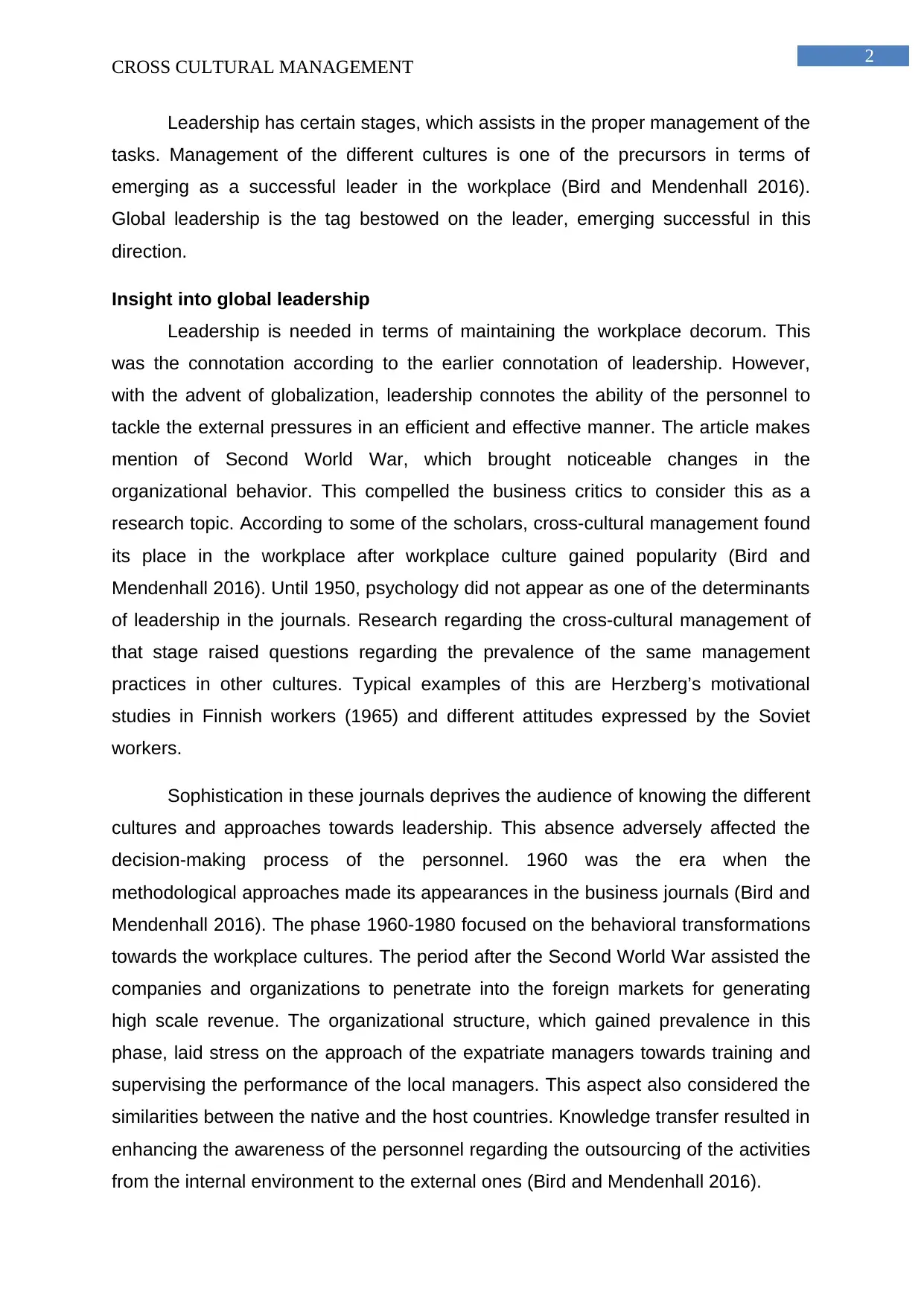
2
CROSS CULTURAL MANAGEMENT
Leadership has certain stages, which assists in the proper management of the
tasks. Management of the different cultures is one of the precursors in terms of
emerging as a successful leader in the workplace (Bird and Mendenhall 2016).
Global leadership is the tag bestowed on the leader, emerging successful in this
direction.
Insight into global leadership
Leadership is needed in terms of maintaining the workplace decorum. This
was the connotation according to the earlier connotation of leadership. However,
with the advent of globalization, leadership connotes the ability of the personnel to
tackle the external pressures in an efficient and effective manner. The article makes
mention of Second World War, which brought noticeable changes in the
organizational behavior. This compelled the business critics to consider this as a
research topic. According to some of the scholars, cross-cultural management found
its place in the workplace after workplace culture gained popularity (Bird and
Mendenhall 2016). Until 1950, psychology did not appear as one of the determinants
of leadership in the journals. Research regarding the cross-cultural management of
that stage raised questions regarding the prevalence of the same management
practices in other cultures. Typical examples of this are Herzberg’s motivational
studies in Finnish workers (1965) and different attitudes expressed by the Soviet
workers.
Sophistication in these journals deprives the audience of knowing the different
cultures and approaches towards leadership. This absence adversely affected the
decision-making process of the personnel. 1960 was the era when the
methodological approaches made its appearances in the business journals (Bird and
Mendenhall 2016). The phase 1960-1980 focused on the behavioral transformations
towards the workplace cultures. The period after the Second World War assisted the
companies and organizations to penetrate into the foreign markets for generating
high scale revenue. The organizational structure, which gained prevalence in this
phase, laid stress on the approach of the expatriate managers towards training and
supervising the performance of the local managers. This aspect also considered the
similarities between the native and the host countries. Knowledge transfer resulted in
enhancing the awareness of the personnel regarding the outsourcing of the activities
from the internal environment to the external ones (Bird and Mendenhall 2016).
CROSS CULTURAL MANAGEMENT
Leadership has certain stages, which assists in the proper management of the
tasks. Management of the different cultures is one of the precursors in terms of
emerging as a successful leader in the workplace (Bird and Mendenhall 2016).
Global leadership is the tag bestowed on the leader, emerging successful in this
direction.
Insight into global leadership
Leadership is needed in terms of maintaining the workplace decorum. This
was the connotation according to the earlier connotation of leadership. However,
with the advent of globalization, leadership connotes the ability of the personnel to
tackle the external pressures in an efficient and effective manner. The article makes
mention of Second World War, which brought noticeable changes in the
organizational behavior. This compelled the business critics to consider this as a
research topic. According to some of the scholars, cross-cultural management found
its place in the workplace after workplace culture gained popularity (Bird and
Mendenhall 2016). Until 1950, psychology did not appear as one of the determinants
of leadership in the journals. Research regarding the cross-cultural management of
that stage raised questions regarding the prevalence of the same management
practices in other cultures. Typical examples of this are Herzberg’s motivational
studies in Finnish workers (1965) and different attitudes expressed by the Soviet
workers.
Sophistication in these journals deprives the audience of knowing the different
cultures and approaches towards leadership. This absence adversely affected the
decision-making process of the personnel. 1960 was the era when the
methodological approaches made its appearances in the business journals (Bird and
Mendenhall 2016). The phase 1960-1980 focused on the behavioral transformations
towards the workplace cultures. The period after the Second World War assisted the
companies and organizations to penetrate into the foreign markets for generating
high scale revenue. The organizational structure, which gained prevalence in this
phase, laid stress on the approach of the expatriate managers towards training and
supervising the performance of the local managers. This aspect also considered the
similarities between the native and the host countries. Knowledge transfer resulted in
enhancing the awareness of the personnel regarding the outsourcing of the activities
from the internal environment to the external ones (Bird and Mendenhall 2016).
⊘ This is a preview!⊘
Do you want full access?
Subscribe today to unlock all pages.

Trusted by 1+ million students worldwide
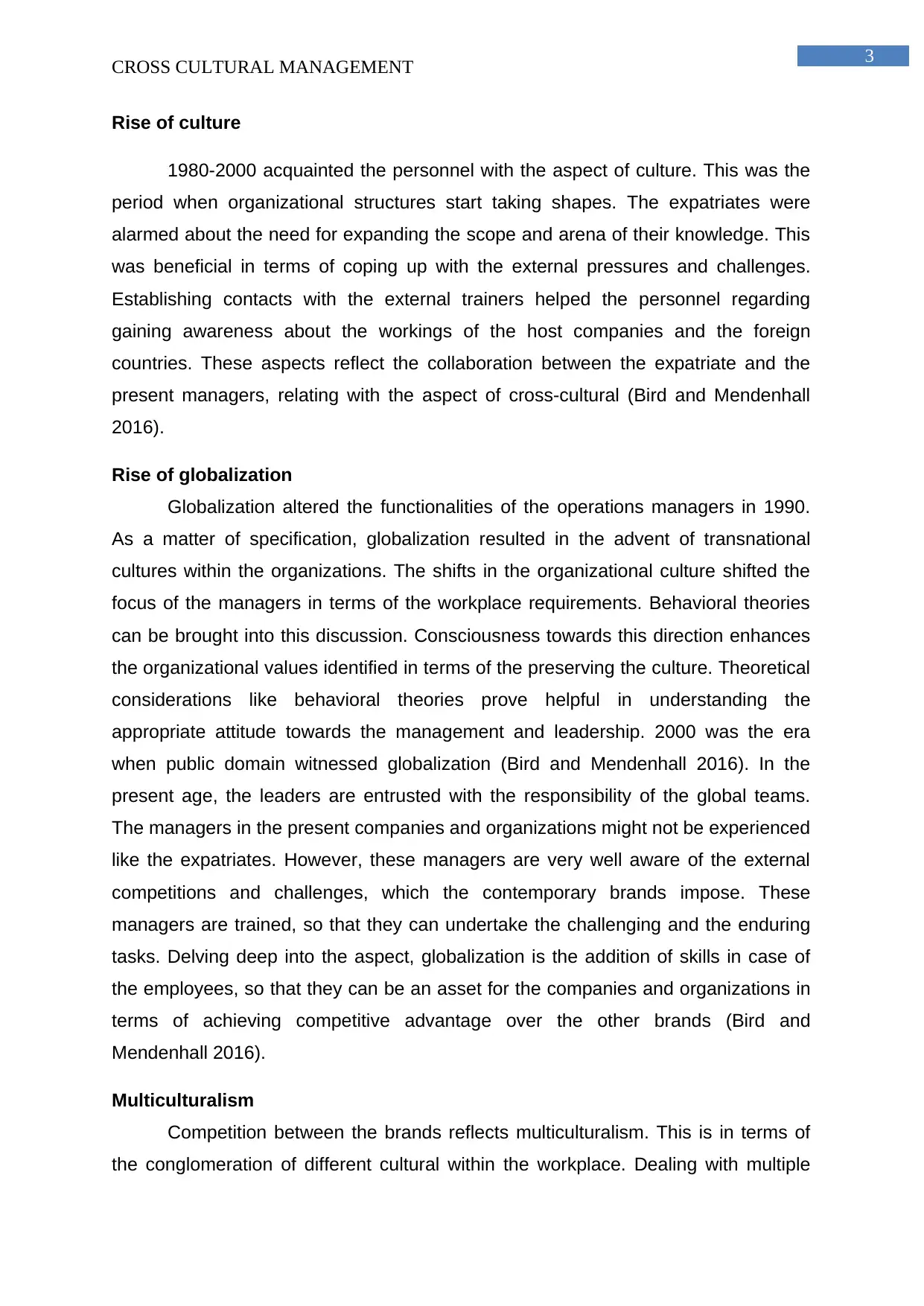
3
CROSS CULTURAL MANAGEMENT
Rise of culture
1980-2000 acquainted the personnel with the aspect of culture. This was the
period when organizational structures start taking shapes. The expatriates were
alarmed about the need for expanding the scope and arena of their knowledge. This
was beneficial in terms of coping up with the external pressures and challenges.
Establishing contacts with the external trainers helped the personnel regarding
gaining awareness about the workings of the host companies and the foreign
countries. These aspects reflect the collaboration between the expatriate and the
present managers, relating with the aspect of cross-cultural (Bird and Mendenhall
2016).
Rise of globalization
Globalization altered the functionalities of the operations managers in 1990.
As a matter of specification, globalization resulted in the advent of transnational
cultures within the organizations. The shifts in the organizational culture shifted the
focus of the managers in terms of the workplace requirements. Behavioral theories
can be brought into this discussion. Consciousness towards this direction enhances
the organizational values identified in terms of the preserving the culture. Theoretical
considerations like behavioral theories prove helpful in understanding the
appropriate attitude towards the management and leadership. 2000 was the era
when public domain witnessed globalization (Bird and Mendenhall 2016). In the
present age, the leaders are entrusted with the responsibility of the global teams.
The managers in the present companies and organizations might not be experienced
like the expatriates. However, these managers are very well aware of the external
competitions and challenges, which the contemporary brands impose. These
managers are trained, so that they can undertake the challenging and the enduring
tasks. Delving deep into the aspect, globalization is the addition of skills in case of
the employees, so that they can be an asset for the companies and organizations in
terms of achieving competitive advantage over the other brands (Bird and
Mendenhall 2016).
Multiculturalism
Competition between the brands reflects multiculturalism. This is in terms of
the conglomeration of different cultural within the workplace. Dealing with multiple
CROSS CULTURAL MANAGEMENT
Rise of culture
1980-2000 acquainted the personnel with the aspect of culture. This was the
period when organizational structures start taking shapes. The expatriates were
alarmed about the need for expanding the scope and arena of their knowledge. This
was beneficial in terms of coping up with the external pressures and challenges.
Establishing contacts with the external trainers helped the personnel regarding
gaining awareness about the workings of the host companies and the foreign
countries. These aspects reflect the collaboration between the expatriate and the
present managers, relating with the aspect of cross-cultural (Bird and Mendenhall
2016).
Rise of globalization
Globalization altered the functionalities of the operations managers in 1990.
As a matter of specification, globalization resulted in the advent of transnational
cultures within the organizations. The shifts in the organizational culture shifted the
focus of the managers in terms of the workplace requirements. Behavioral theories
can be brought into this discussion. Consciousness towards this direction enhances
the organizational values identified in terms of the preserving the culture. Theoretical
considerations like behavioral theories prove helpful in understanding the
appropriate attitude towards the management and leadership. 2000 was the era
when public domain witnessed globalization (Bird and Mendenhall 2016). In the
present age, the leaders are entrusted with the responsibility of the global teams.
The managers in the present companies and organizations might not be experienced
like the expatriates. However, these managers are very well aware of the external
competitions and challenges, which the contemporary brands impose. These
managers are trained, so that they can undertake the challenging and the enduring
tasks. Delving deep into the aspect, globalization is the addition of skills in case of
the employees, so that they can be an asset for the companies and organizations in
terms of achieving competitive advantage over the other brands (Bird and
Mendenhall 2016).
Multiculturalism
Competition between the brands reflects multiculturalism. This is in terms of
the conglomeration of different cultural within the workplace. Dealing with multiple
Paraphrase This Document
Need a fresh take? Get an instant paraphrase of this document with our AI Paraphraser
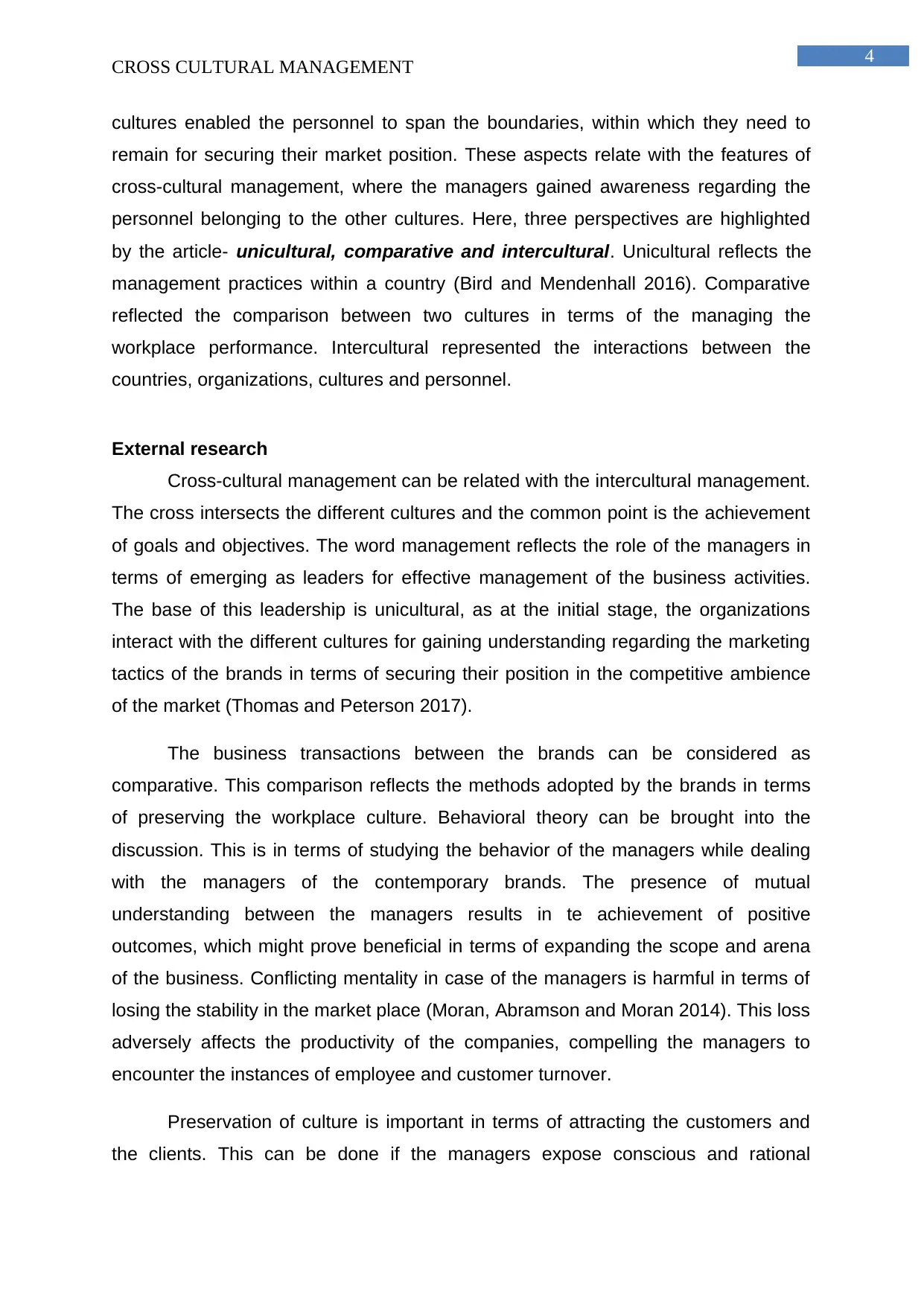
4
CROSS CULTURAL MANAGEMENT
cultures enabled the personnel to span the boundaries, within which they need to
remain for securing their market position. These aspects relate with the features of
cross-cultural management, where the managers gained awareness regarding the
personnel belonging to the other cultures. Here, three perspectives are highlighted
by the article- unicultural, comparative and intercultural. Unicultural reflects the
management practices within a country (Bird and Mendenhall 2016). Comparative
reflected the comparison between two cultures in terms of the managing the
workplace performance. Intercultural represented the interactions between the
countries, organizations, cultures and personnel.
External research
Cross-cultural management can be related with the intercultural management.
The cross intersects the different cultures and the common point is the achievement
of goals and objectives. The word management reflects the role of the managers in
terms of emerging as leaders for effective management of the business activities.
The base of this leadership is unicultural, as at the initial stage, the organizations
interact with the different cultures for gaining understanding regarding the marketing
tactics of the brands in terms of securing their position in the competitive ambience
of the market (Thomas and Peterson 2017).
The business transactions between the brands can be considered as
comparative. This comparison reflects the methods adopted by the brands in terms
of preserving the workplace culture. Behavioral theory can be brought into the
discussion. This is in terms of studying the behavior of the managers while dealing
with the managers of the contemporary brands. The presence of mutual
understanding between the managers results in te achievement of positive
outcomes, which might prove beneficial in terms of expanding the scope and arena
of the business. Conflicting mentality in case of the managers is harmful in terms of
losing the stability in the market place (Moran, Abramson and Moran 2014). This loss
adversely affects the productivity of the companies, compelling the managers to
encounter the instances of employee and customer turnover.
Preservation of culture is important in terms of attracting the customers and
the clients. This can be done if the managers expose conscious and rational
CROSS CULTURAL MANAGEMENT
cultures enabled the personnel to span the boundaries, within which they need to
remain for securing their market position. These aspects relate with the features of
cross-cultural management, where the managers gained awareness regarding the
personnel belonging to the other cultures. Here, three perspectives are highlighted
by the article- unicultural, comparative and intercultural. Unicultural reflects the
management practices within a country (Bird and Mendenhall 2016). Comparative
reflected the comparison between two cultures in terms of the managing the
workplace performance. Intercultural represented the interactions between the
countries, organizations, cultures and personnel.
External research
Cross-cultural management can be related with the intercultural management.
The cross intersects the different cultures and the common point is the achievement
of goals and objectives. The word management reflects the role of the managers in
terms of emerging as leaders for effective management of the business activities.
The base of this leadership is unicultural, as at the initial stage, the organizations
interact with the different cultures for gaining understanding regarding the marketing
tactics of the brands in terms of securing their position in the competitive ambience
of the market (Thomas and Peterson 2017).
The business transactions between the brands can be considered as
comparative. This comparison reflects the methods adopted by the brands in terms
of preserving the workplace culture. Behavioral theory can be brought into the
discussion. This is in terms of studying the behavior of the managers while dealing
with the managers of the contemporary brands. The presence of mutual
understanding between the managers results in te achievement of positive
outcomes, which might prove beneficial in terms of expanding the scope and arena
of the business. Conflicting mentality in case of the managers is harmful in terms of
losing the stability in the market place (Moran, Abramson and Moran 2014). This loss
adversely affects the productivity of the companies, compelling the managers to
encounter the instances of employee and customer turnover.
Preservation of culture is important in terms of attracting the customers and
the clients. This can be done if the managers expose conscious and rational
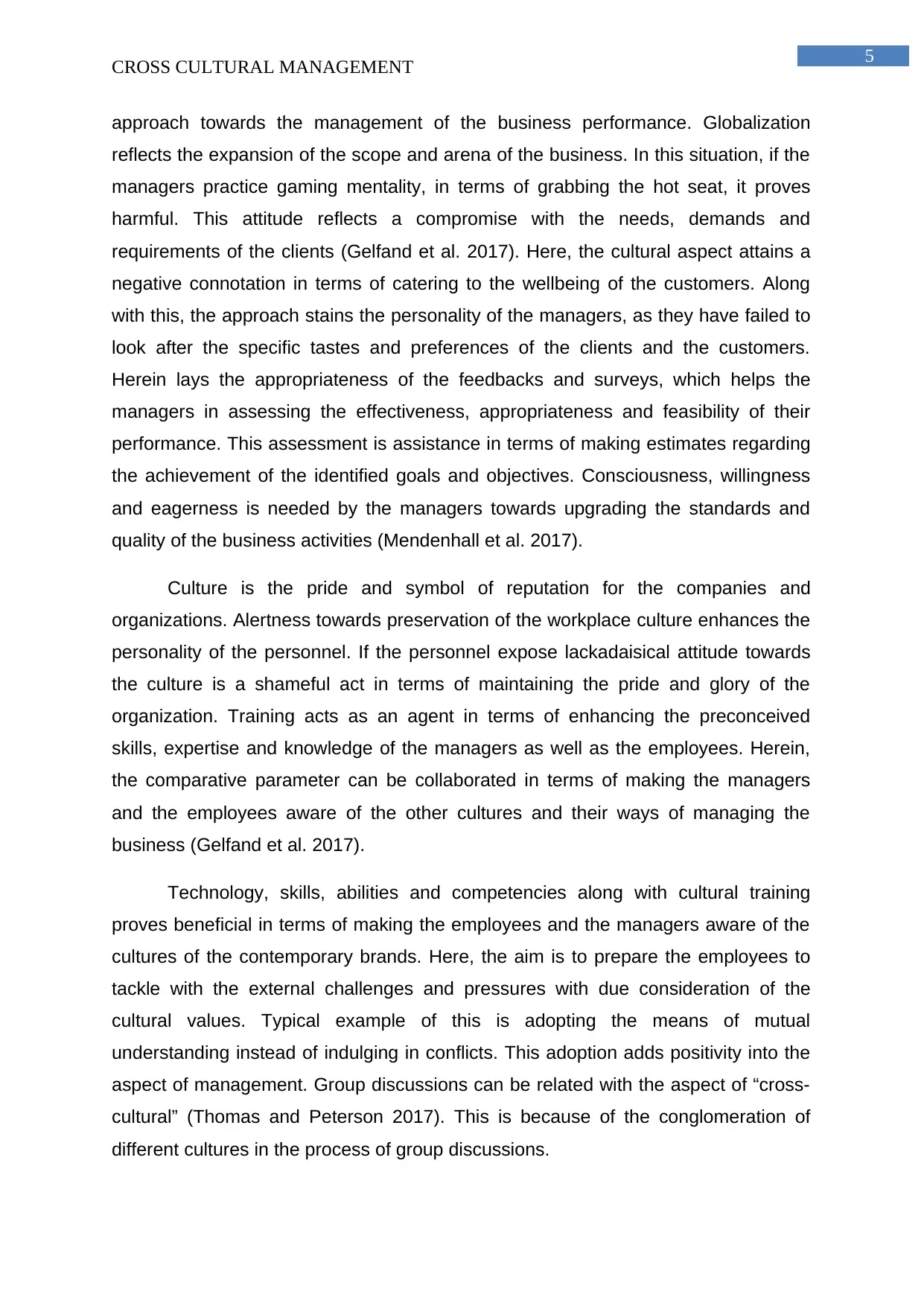
5
CROSS CULTURAL MANAGEMENT
approach towards the management of the business performance. Globalization
reflects the expansion of the scope and arena of the business. In this situation, if the
managers practice gaming mentality, in terms of grabbing the hot seat, it proves
harmful. This attitude reflects a compromise with the needs, demands and
requirements of the clients (Gelfand et al. 2017). Here, the cultural aspect attains a
negative connotation in terms of catering to the wellbeing of the customers. Along
with this, the approach stains the personality of the managers, as they have failed to
look after the specific tastes and preferences of the clients and the customers.
Herein lays the appropriateness of the feedbacks and surveys, which helps the
managers in assessing the effectiveness, appropriateness and feasibility of their
performance. This assessment is assistance in terms of making estimates regarding
the achievement of the identified goals and objectives. Consciousness, willingness
and eagerness is needed by the managers towards upgrading the standards and
quality of the business activities (Mendenhall et al. 2017).
Culture is the pride and symbol of reputation for the companies and
organizations. Alertness towards preservation of the workplace culture enhances the
personality of the personnel. If the personnel expose lackadaisical attitude towards
the culture is a shameful act in terms of maintaining the pride and glory of the
organization. Training acts as an agent in terms of enhancing the preconceived
skills, expertise and knowledge of the managers as well as the employees. Herein,
the comparative parameter can be collaborated in terms of making the managers
and the employees aware of the other cultures and their ways of managing the
business (Gelfand et al. 2017).
Technology, skills, abilities and competencies along with cultural training
proves beneficial in terms of making the employees and the managers aware of the
cultures of the contemporary brands. Here, the aim is to prepare the employees to
tackle with the external challenges and pressures with due consideration of the
cultural values. Typical example of this is adopting the means of mutual
understanding instead of indulging in conflicts. This adoption adds positivity into the
aspect of management. Group discussions can be related with the aspect of “cross-
cultural” (Thomas and Peterson 2017). This is because of the conglomeration of
different cultures in the process of group discussions.
CROSS CULTURAL MANAGEMENT
approach towards the management of the business performance. Globalization
reflects the expansion of the scope and arena of the business. In this situation, if the
managers practice gaming mentality, in terms of grabbing the hot seat, it proves
harmful. This attitude reflects a compromise with the needs, demands and
requirements of the clients (Gelfand et al. 2017). Here, the cultural aspect attains a
negative connotation in terms of catering to the wellbeing of the customers. Along
with this, the approach stains the personality of the managers, as they have failed to
look after the specific tastes and preferences of the clients and the customers.
Herein lays the appropriateness of the feedbacks and surveys, which helps the
managers in assessing the effectiveness, appropriateness and feasibility of their
performance. This assessment is assistance in terms of making estimates regarding
the achievement of the identified goals and objectives. Consciousness, willingness
and eagerness is needed by the managers towards upgrading the standards and
quality of the business activities (Mendenhall et al. 2017).
Culture is the pride and symbol of reputation for the companies and
organizations. Alertness towards preservation of the workplace culture enhances the
personality of the personnel. If the personnel expose lackadaisical attitude towards
the culture is a shameful act in terms of maintaining the pride and glory of the
organization. Training acts as an agent in terms of enhancing the preconceived
skills, expertise and knowledge of the managers as well as the employees. Herein,
the comparative parameter can be collaborated in terms of making the managers
and the employees aware of the other cultures and their ways of managing the
business (Gelfand et al. 2017).
Technology, skills, abilities and competencies along with cultural training
proves beneficial in terms of making the employees and the managers aware of the
cultures of the contemporary brands. Here, the aim is to prepare the employees to
tackle with the external challenges and pressures with due consideration of the
cultural values. Typical example of this is adopting the means of mutual
understanding instead of indulging in conflicts. This adoption adds positivity into the
aspect of management. Group discussions can be related with the aspect of “cross-
cultural” (Thomas and Peterson 2017). This is because of the conglomeration of
different cultures in the process of group discussions.
⊘ This is a preview!⊘
Do you want full access?
Subscribe today to unlock all pages.

Trusted by 1+ million students worldwide
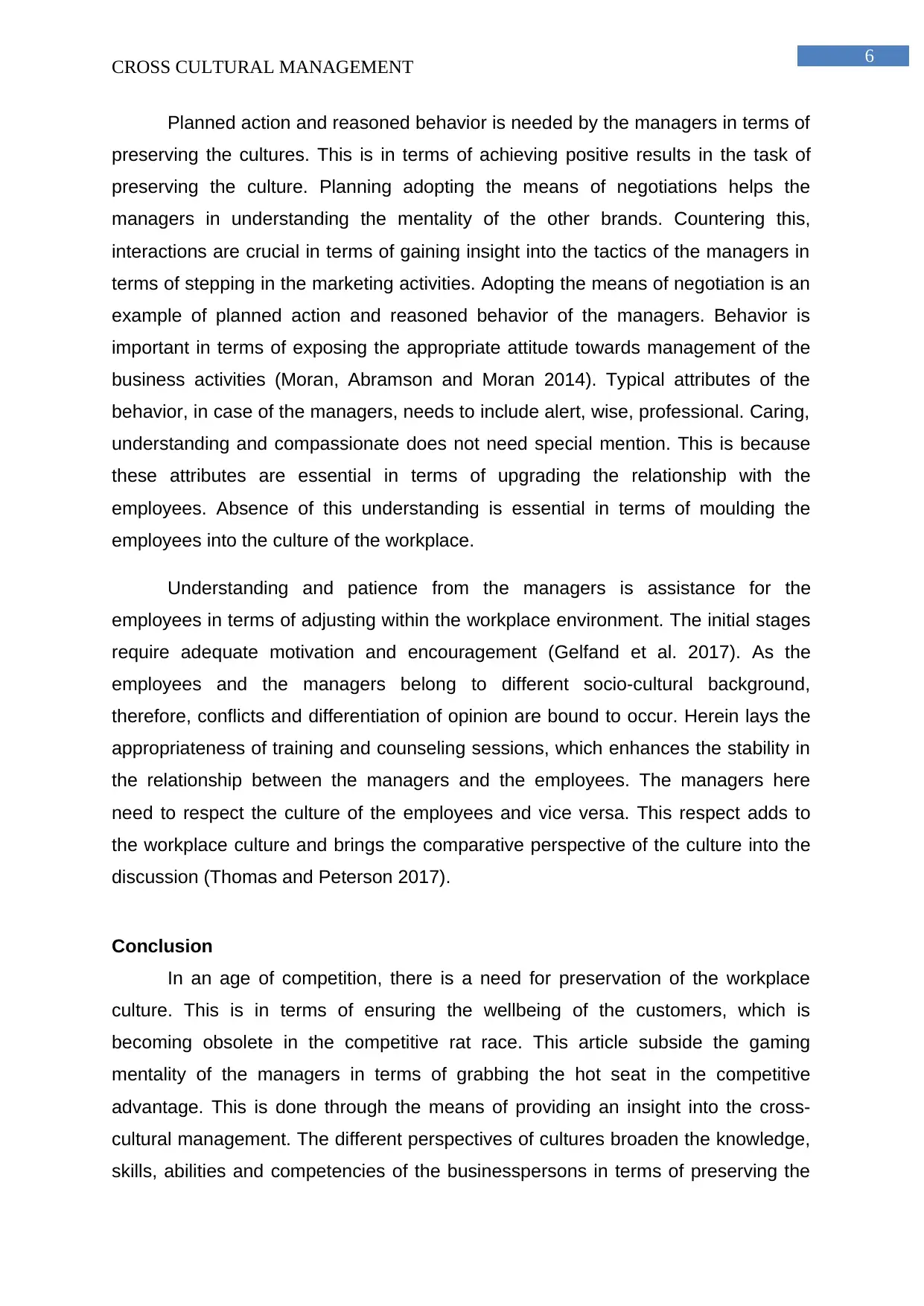
6
CROSS CULTURAL MANAGEMENT
Planned action and reasoned behavior is needed by the managers in terms of
preserving the cultures. This is in terms of achieving positive results in the task of
preserving the culture. Planning adopting the means of negotiations helps the
managers in understanding the mentality of the other brands. Countering this,
interactions are crucial in terms of gaining insight into the tactics of the managers in
terms of stepping in the marketing activities. Adopting the means of negotiation is an
example of planned action and reasoned behavior of the managers. Behavior is
important in terms of exposing the appropriate attitude towards management of the
business activities (Moran, Abramson and Moran 2014). Typical attributes of the
behavior, in case of the managers, needs to include alert, wise, professional. Caring,
understanding and compassionate does not need special mention. This is because
these attributes are essential in terms of upgrading the relationship with the
employees. Absence of this understanding is essential in terms of moulding the
employees into the culture of the workplace.
Understanding and patience from the managers is assistance for the
employees in terms of adjusting within the workplace environment. The initial stages
require adequate motivation and encouragement (Gelfand et al. 2017). As the
employees and the managers belong to different socio-cultural background,
therefore, conflicts and differentiation of opinion are bound to occur. Herein lays the
appropriateness of training and counseling sessions, which enhances the stability in
the relationship between the managers and the employees. The managers here
need to respect the culture of the employees and vice versa. This respect adds to
the workplace culture and brings the comparative perspective of the culture into the
discussion (Thomas and Peterson 2017).
Conclusion
In an age of competition, there is a need for preservation of the workplace
culture. This is in terms of ensuring the wellbeing of the customers, which is
becoming obsolete in the competitive rat race. This article subside the gaming
mentality of the managers in terms of grabbing the hot seat in the competitive
advantage. This is done through the means of providing an insight into the cross-
cultural management. The different perspectives of cultures broaden the knowledge,
skills, abilities and competencies of the businesspersons in terms of preserving the
CROSS CULTURAL MANAGEMENT
Planned action and reasoned behavior is needed by the managers in terms of
preserving the cultures. This is in terms of achieving positive results in the task of
preserving the culture. Planning adopting the means of negotiations helps the
managers in understanding the mentality of the other brands. Countering this,
interactions are crucial in terms of gaining insight into the tactics of the managers in
terms of stepping in the marketing activities. Adopting the means of negotiation is an
example of planned action and reasoned behavior of the managers. Behavior is
important in terms of exposing the appropriate attitude towards management of the
business activities (Moran, Abramson and Moran 2014). Typical attributes of the
behavior, in case of the managers, needs to include alert, wise, professional. Caring,
understanding and compassionate does not need special mention. This is because
these attributes are essential in terms of upgrading the relationship with the
employees. Absence of this understanding is essential in terms of moulding the
employees into the culture of the workplace.
Understanding and patience from the managers is assistance for the
employees in terms of adjusting within the workplace environment. The initial stages
require adequate motivation and encouragement (Gelfand et al. 2017). As the
employees and the managers belong to different socio-cultural background,
therefore, conflicts and differentiation of opinion are bound to occur. Herein lays the
appropriateness of training and counseling sessions, which enhances the stability in
the relationship between the managers and the employees. The managers here
need to respect the culture of the employees and vice versa. This respect adds to
the workplace culture and brings the comparative perspective of the culture into the
discussion (Thomas and Peterson 2017).
Conclusion
In an age of competition, there is a need for preservation of the workplace
culture. This is in terms of ensuring the wellbeing of the customers, which is
becoming obsolete in the competitive rat race. This article subside the gaming
mentality of the managers in terms of grabbing the hot seat in the competitive
advantage. This is done through the means of providing an insight into the cross-
cultural management. The different perspectives of cultures broaden the knowledge,
skills, abilities and competencies of the businesspersons in terms of preserving the
Paraphrase This Document
Need a fresh take? Get an instant paraphrase of this document with our AI Paraphraser
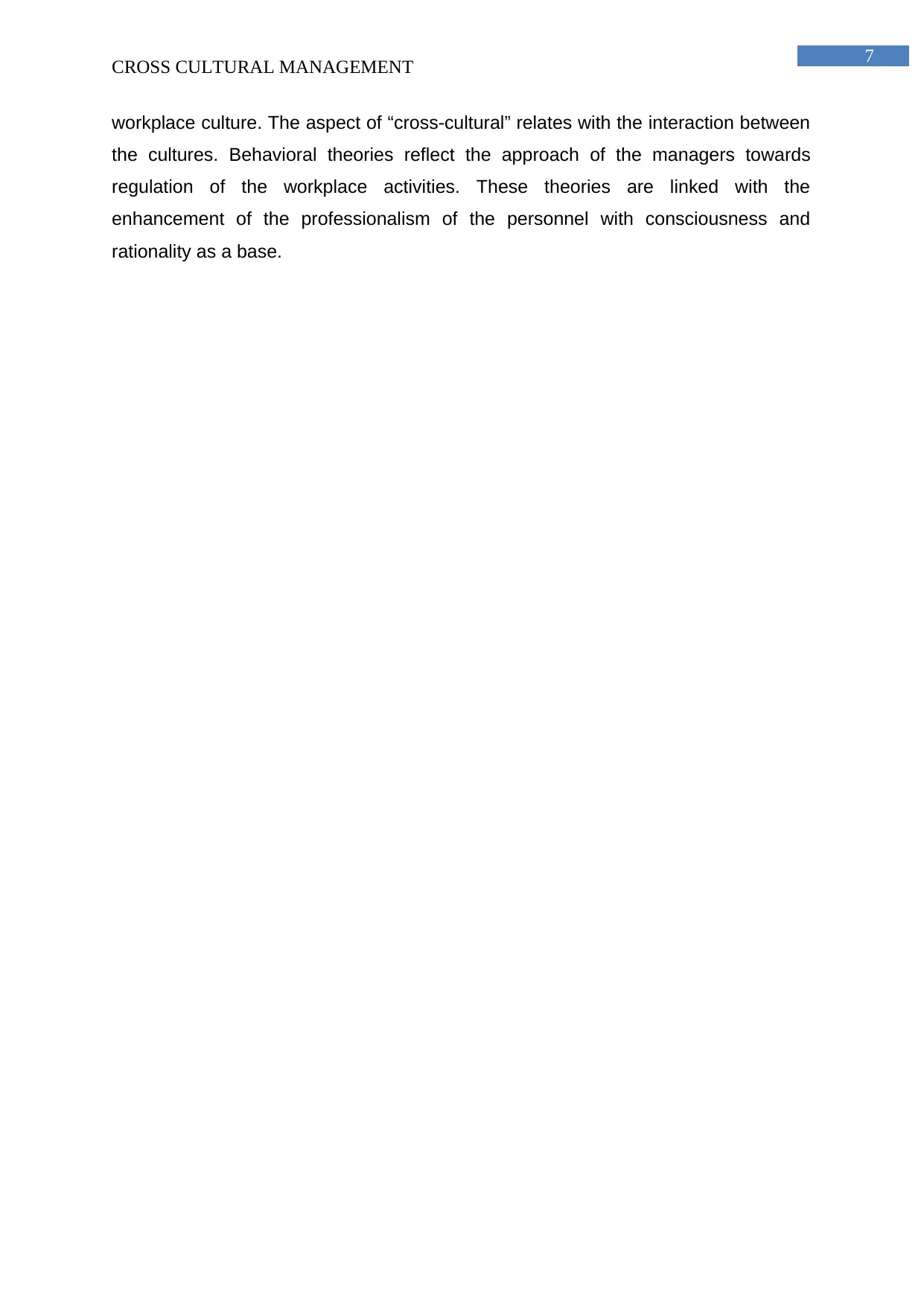
7
CROSS CULTURAL MANAGEMENT
workplace culture. The aspect of “cross-cultural” relates with the interaction between
the cultures. Behavioral theories reflect the approach of the managers towards
regulation of the workplace activities. These theories are linked with the
enhancement of the professionalism of the personnel with consciousness and
rationality as a base.
CROSS CULTURAL MANAGEMENT
workplace culture. The aspect of “cross-cultural” relates with the interaction between
the cultures. Behavioral theories reflect the approach of the managers towards
regulation of the workplace activities. These theories are linked with the
enhancement of the professionalism of the personnel with consciousness and
rationality as a base.
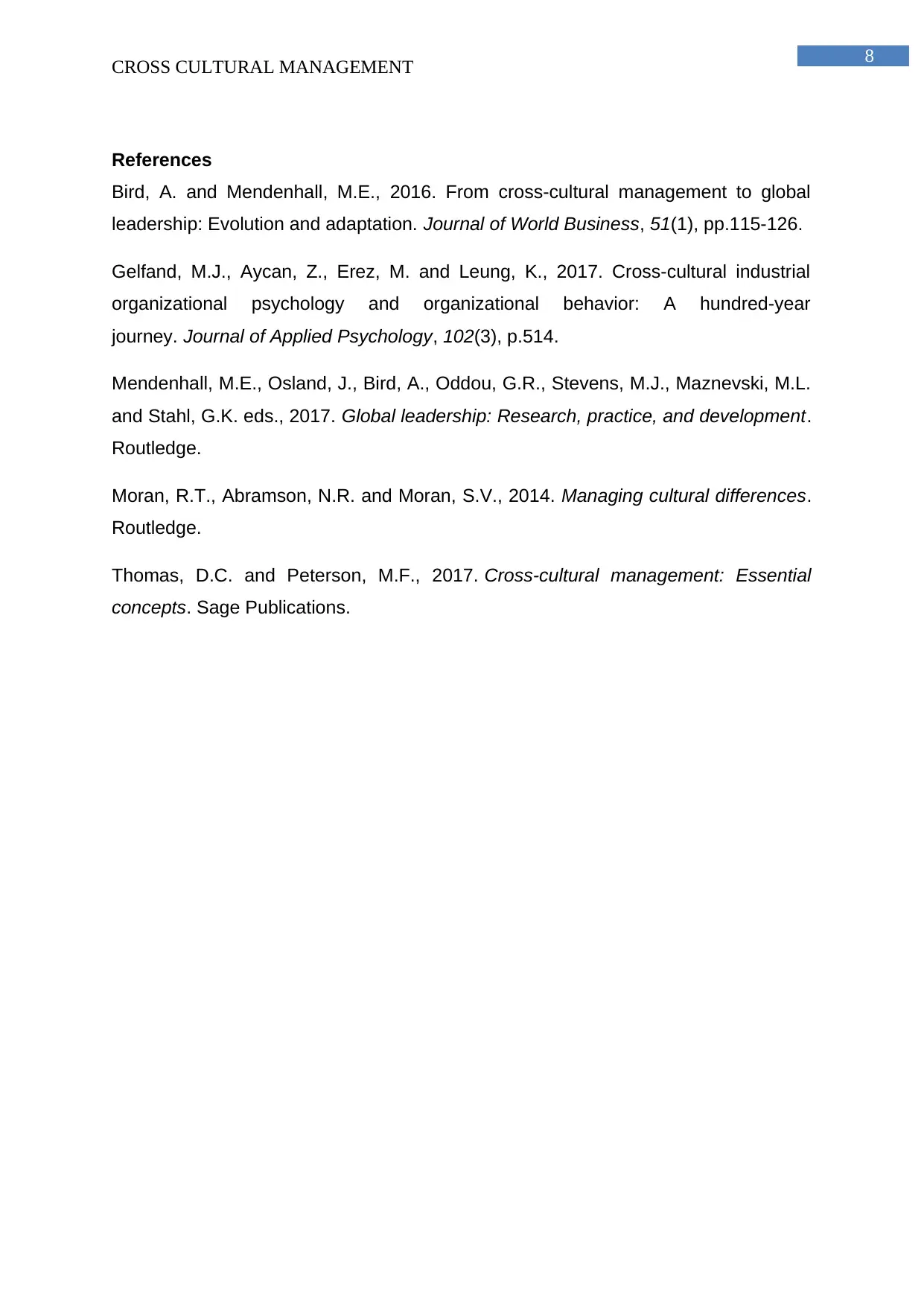
8
CROSS CULTURAL MANAGEMENT
References
Bird, A. and Mendenhall, M.E., 2016. From cross-cultural management to global
leadership: Evolution and adaptation. Journal of World Business, 51(1), pp.115-126.
Gelfand, M.J., Aycan, Z., Erez, M. and Leung, K., 2017. Cross-cultural industrial
organizational psychology and organizational behavior: A hundred-year
journey. Journal of Applied Psychology, 102(3), p.514.
Mendenhall, M.E., Osland, J., Bird, A., Oddou, G.R., Stevens, M.J., Maznevski, M.L.
and Stahl, G.K. eds., 2017. Global leadership: Research, practice, and development.
Routledge.
Moran, R.T., Abramson, N.R. and Moran, S.V., 2014. Managing cultural differences.
Routledge.
Thomas, D.C. and Peterson, M.F., 2017. Cross-cultural management: Essential
concepts. Sage Publications.
CROSS CULTURAL MANAGEMENT
References
Bird, A. and Mendenhall, M.E., 2016. From cross-cultural management to global
leadership: Evolution and adaptation. Journal of World Business, 51(1), pp.115-126.
Gelfand, M.J., Aycan, Z., Erez, M. and Leung, K., 2017. Cross-cultural industrial
organizational psychology and organizational behavior: A hundred-year
journey. Journal of Applied Psychology, 102(3), p.514.
Mendenhall, M.E., Osland, J., Bird, A., Oddou, G.R., Stevens, M.J., Maznevski, M.L.
and Stahl, G.K. eds., 2017. Global leadership: Research, practice, and development.
Routledge.
Moran, R.T., Abramson, N.R. and Moran, S.V., 2014. Managing cultural differences.
Routledge.
Thomas, D.C. and Peterson, M.F., 2017. Cross-cultural management: Essential
concepts. Sage Publications.
⊘ This is a preview!⊘
Do you want full access?
Subscribe today to unlock all pages.

Trusted by 1+ million students worldwide
1 out of 9
Related Documents
Your All-in-One AI-Powered Toolkit for Academic Success.
+13062052269
info@desklib.com
Available 24*7 on WhatsApp / Email
![[object Object]](/_next/static/media/star-bottom.7253800d.svg)
Unlock your academic potential
Copyright © 2020–2025 A2Z Services. All Rights Reserved. Developed and managed by ZUCOL.





